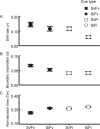Space- and feature-based attention operate both independently and interactively within latent components of perceptual decision making
- PMID: 36656593
- PMCID: PMC9872836
- DOI: 10.1167/jov.23.1.12
Space- and feature-based attention operate both independently and interactively within latent components of perceptual decision making
Abstract
Top-down visual attention filters undesired stimuli while selected information is afforded the lion's share of limited cognitive resources. Multiple selection mechanisms can be deployed simultaneously, but how unique influences of each combine to facilitate behavior remains unclear. Previously, we failed to observe an additive perceptual benefit when both space-based attention (SBA) and feature-based attention (FBA) were cued in a sparse display (Liang & Scolari, 2020): FBA was restricted to higher order decision-making processes when combined with a valid spatial cue, whereas SBA additionally facilitated target enhancement. Here, we introduced a series of design modifications across three experiments to elicit both attention mechanisms within signal enhancement while also investigating the impacts on decision making. First, we found that when highly reliable spatial and feature cues made unique contributions to search (experiment 1), or when each cue component was moderately reliable (experiments 2a and 2b), both mechanisms were deployed independently to resolve the target. However, the same manipulations produced interactive attention effects within other latent decision-making components that depended on the probability of the integrated cueing object. Time spent before evidence accumulation was reduced and responses were more conservative for the most likely pre-cue combination-even when it included an invalid component. These data indicate that selection mechanisms operate on sensory signals invariably in an independent manner, whereas a higher-order dependency occurs outside of signal enhancement.
Figures






Similar articles
-
Limited interactions between space- and feature-based attention in visually sparse displays.J Vis. 2020 Apr 9;20(4):5. doi: 10.1167/jov.20.4.5. J Vis. 2020. PMID: 32271894 Free PMC article.
-
Bias corrected double judgment accuracy during spatial attention cueing: unmasked stimuli with non-predictive and semi-predictive cues.Vision Res. 2014 Dec;105:213-25. doi: 10.1016/j.visres.2014.07.017. Epub 2014 Aug 15. Vision Res. 2014. PMID: 25130410
-
Feature-based attention elicited by precueing in an orientation discrimination task.Vision Res. 2018 Jul;148:15-25. doi: 10.1016/j.visres.2018.05.001. Epub 2018 May 16. Vision Res. 2018. PMID: 29763696
-
The impact of probabilistic feature cueing depends on the level of cue abstraction.Exp Brain Res. 2016 Mar;234(3):685-94. doi: 10.1007/s00221-015-4487-2. Epub 2015 Nov 19. Exp Brain Res. 2016. PMID: 26586268
-
The role of top-down spatial attention in contingent attentional capture.Psychophysiology. 2016 May;53(5):650-62. doi: 10.1111/psyp.12615. Epub 2016 Feb 16. Psychophysiology. 2016. PMID: 26879628
Cited by
-
Representational structures as a unifying framework for attention.Trends Cogn Sci. 2024 May;28(5):416-427. doi: 10.1016/j.tics.2024.01.002. Epub 2024 Jan 27. Trends Cogn Sci. 2024. PMID: 38280837 Free PMC article. Review.
References
-
- Arjona, A., Escudero, M., & Gómez, C. M. (2016). Cue validity probability influences neural processing of targets. Biological Psychology, 119, 171–183. - PubMed
-
- Ásgeirsson, Á. G., Kristjánsson, Á., & Bundesen, C. (2014). Independent priming of location and color in identification of briefly presented letters. Attention, Perception, & Psychophysics, 76(1), 40–48. - PubMed
-
- Bengson, J. J., Mangun, G. R., & Mazaheri, A. (2012). The neural markers of an imminent failure of response inhibition. Neuroimage, 59(2), 1534–1539. - PubMed
-
- Carrasco, M. (2006). Covert attention increases contrast sensitivity: Psychophysical, neurophysiological and neuroimaging studies. Progress in Brain Research, 154, 33–70. - PubMed
-
- Clyde, M. A., Ghosh, J., & Littman, M. L. (2011). Bayesian adaptive sampling for variable selection and model averaging. Journal of Computational and Graphical Statistics, 20(1), 80–101.
MeSH terms
LinkOut - more resources
Full Text Sources

